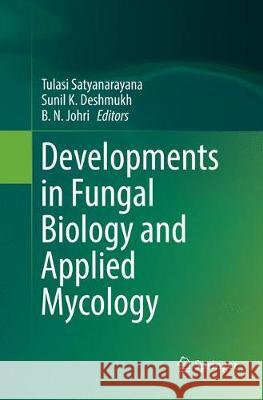Developments in Fungal Biology and Applied Mycology » książka



Developments in Fungal Biology and Applied Mycology
ISBN-13: 9789811352256 / Angielski / Miękka / 2018 / 605 str.
Developments in Fungal Biology and Applied Mycology
ISBN-13: 9789811352256 / Angielski / Miękka / 2018 / 605 str.
(netto: 1147,46 VAT: 5%)
Najniższa cena z 30 dni: 1156,64
ok. 22 dni roboczych.
Darmowa dostawa!
1. Significant contributions of Prof. Shyam Bahadur Saksena to Indian mycology
R. S. Mehrotra, M.R. Siddiqui and Ashok Aggarwal
2. Biology and significance of Saksenea vasiformis
Itisha Singh and R.K.S.Kushwaha
3. History of Mycology in India: Some Glimpses
C. Manoharachary
4.Various aspects of ammonia fungi
Akira Suzuki
5. Marine Filamentous Fungi: Diversity, Distribution and Bioprospecting
K.R. Sridhar,
6. Keratinophilic Fungi and Their Biotechnological Potentials
ShilpaVerekar and Sunil Kumar Deshmukh
7. Fungal World of Cave Ecosystem
Seema Rawat, Rachna Rautela and B.N. Johri
8. Biology of Anaerobic Gut Fungi
D.N. Kamra and Birbal Singh
;
9.. Fusarium oxysporum: Genomics, diversity and plant host interaction
Anjul Rana, ManvikaSahgal and Bhavdish N Johri
10. Yeast genome sequencing: basic biology to biotechnology
Krishna Kant Sharma
11. Fungal differentiation: A model phenomenon to screen antifungal drugs
E. K. Pathan, S. G. Tupe and M.V. Deshpande
12. Candida albicans Biofilm as a Clinical Challenge
;Ashwini Jadhav and Sankunny Mohan Karuppayil
13. Characteristics and multifarious potential applications of HAP phytase of the
unconventional yeast Pichia anomala
Swati Joshi and T. Satyanarayana
14. Fungal Inulinolytic Enzymes: A current appraisal
Hemant Kumar Rawat, Hemant Soni and Naveen Kango
15. Fungal Tannase: Recent advances and industrial applications
Sunny Dhiman,Anu Kumar, Gunjan Mukherjee, Papiya Mukherjee, Sunil Kumar Deshmukh &n
bsp;16. Mycoremediation: an alternative treatment option for heavy metal bearing waste
water
TuhinaVerma, Annapurna Maurya, Satyendra Kumar Garg
17. Treatment of landfill leachate using fungi: An efficient and cost-effective strategy
Pooja Ghosh and Indu Shekhar Thakur
18. Studies on Mycorrhizae in Pinus gerardiana, a threatened pine of the NW Himalayas
Sunil Kumar, VaneetJishtu, J.S. Thakur and TN Lakhanpal
19. Role of phosphate solubilizing fungi in sustainable agriculture
Gurdeep Kaur and M. Sudhakara Reddy
20. Role of Fungicides in Crop Health Management: Prospects and Challenges
T.S. Thind
21. Bioherbicides: Strategies, Challenges and Prospects
K. R. Aneja, S. A. Khan and A. Aneja
22. Characterization of Lamellate Mushrooms - An Appra
isalN. S. Atri, Munruchi Kaur and Samidha Sharma
23. Occurrence and distribution of mushrooms in semi – ever green Sal (Shorearobusta)
forest Chhattisgarh, Central - India. Kamlesh Shukla, R.V. Shukla
24. Fungal Pigments
Gunjan Mukherjee, Tulika Mishra, Sunil Kumar Deshmukh
25. Ex-situ Conservation of Fungi
Sanjay K. Singh
26. Camouflaged mycotoxins in some field crops and forages
SkarmaNonzom and Geeta SumbaliProf. T. Satyanarayana became a faculty fellow at the Division of Biological Sciences & Engineering, Netaji Subhas Institute of Technology (affiliated to the University of Delhi), New Delhi after retiring from Department of Microbiology, University of Delhi South Campus, New Delhi in 2016. He has over 270 scientific papers and reviews, 6 edited books and 3 patents to his credit. He is a fellow of National Academy of Agricultural Sciences (NAAS), the Association of Microbiologists of India (AMI), the Biotech Research Society (I) and the Mycological Society of India (MSI). He has 40 years of research and teaching experience and was president of the AMI and MSI. His research has focused on understanding the diversity and applications of yeasts, thermophilic fungi and bacteria and their enzymes as well as carbon sequestration using extremophilic bacterial carbonic anhydrases.
Dr. Bhavdish N Johri is a professor and NASI senior scientist at the Department of Biotechnology & Bioinformatics Centre, Barkatullah University, India. He has been the recipient of many academic awards, including the Indian National Science Academy’s Young Scientist Medal, Rafi Kidwai Memorial award and Acharya PC Ray Fellowship (MPCST). He is a fellow of the National Academy of Sciences (I), National Academy of Agricultural Sciences and National Institute of Ecology. He has extensive teaching and research experience, and has 148 research publications and 3 edited books to his credit.
Dr. Sunil Kumar Deshmukh is a fellow and area convenor at the Nano-Biotechnology Research Centre, The Energy and Resources Institute (TERI), New Delhi. He was assistant director (Natural Products) at Piramal Enterprises Ltd., Mumbai. He has broad industrial experience in the field of applied microbiology. He is now president of the Mycological Society of India. He has 100 publications and eight patent to his credit. He has also edited seven books.
This book explores the developments in important aspects of fungi related to the environment, industrial mycology, microbiology, biotechnology, and agriculture. It discusses at length both basic and applied aspects of fungi and provides up-to-date laboratory-based data.
Of the estimated three million species of fungi on Earth, according to Hawksworth and coworkers, more than 100,000 have been described to date. Many fungi produce toxins, organic acids, antibiotics and other secondary metabolites, and are sources of useful biocatalysts such as cellulases, xylanases, proteases and pectinases, to mention a few. They can also cause diseases in animals as well as plants and many are able to break down complex organic molecules such as lignin and pollutants like xenobiotics, petroleum and polycyclic aromatic compounds. Current research on mushrooms focuses on their hypoglycemic, anti-cancer, anti-pathogenic and immunity-enhancing activities.
This ready-reference resource on various aspects of fungi is intended for graduate and post-graduate students as well as researchers in life sciences, microbiology, botany, environmental sciences and biotechnology.
1997-2026 DolnySlask.com Agencja Internetowa
KrainaKsiazek.PL - Księgarnia Internetowa









